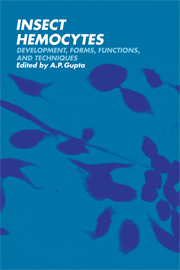Book contents
- Frontmatter
- Contents
- Preface
- List of contributors
- Part I Development and differentiation
- Part II Forms and structure
- Part III Functions
- Part IV Techniques
- 17 Identification key for hemocyte types in hanging-drop preparations
- 18 Insect hemocytes under light microscopy: techniques
- 19 Techniques for total and differential hemocyte counts and blood volume, and mitotic index determinations
- 20 Hemocyte techniques: advantages and disadvantages
- 21 Light, transmission, and scanning electron microscopic techniques for insect hemocytes
- 22 Histochemical methods for hemocytes
- Indexes
19 - Techniques for total and differential hemocyte counts and blood volume, and mitotic index determinations
Published online by Cambridge University Press: 04 August 2010
- Frontmatter
- Contents
- Preface
- List of contributors
- Part I Development and differentiation
- Part II Forms and structure
- Part III Functions
- Part IV Techniques
- 17 Identification key for hemocyte types in hanging-drop preparations
- 18 Insect hemocytes under light microscopy: techniques
- 19 Techniques for total and differential hemocyte counts and blood volume, and mitotic index determinations
- 20 Hemocyte techniques: advantages and disadvantages
- 21 Light, transmission, and scanning electron microscopic techniques for insect hemocytes
- 22 Histochemical methods for hemocytes
- Indexes
Summary
Introduction
The three most common measurements made to describe the blood picture of a given insect at a given time or from one time to another are total hemocyte count (THC), differential hemocyte count (DHC), and blood volume (BV). The purpose of this chapter is to examine the methods used to obtain these values and their reliability.
Total hemocyte count
The first study of THCs in insects was made by Tauber and Yeager (1934). In 1935, they studied Orthoptera, Odonata, Hemiptera, and Homoptera. A year later, these same authors extended their study to include Neuroptera, Coleoptera, Lepidoptera, and Hymenoptera. The insects were heat-fixed (60 °C for 5–10 min) and bled from a proleg, after which the blood sample was diluted with physiological saline. The THC (i.e., the number of circulating hemocytes per cubic millimeter) was determined by the method employed for mammalian blood counts. This work represents an outstanding contribution and has served as a model for subsequent investigations.
Tauber-Yeager (1935) fluid (NaCl, 4.65 g; KC1, 0.15 g; CaCl2, 0.11 g; gentian violet, 0.005 g; and 0.125 ml acetic acid/100 ml) was used also by Fisher (1935), Smith (1938), and Shapiro (1967, 1968). Other physiological saline solutions were utilized by Rosenberger and Jones (1960), Collin (1963), and Gupta and Sutherland (1968). Acetic acid, a component of the Tauber-Yeager fluid, was used for Galleria (Stephens, 1963; Shapiro, 1966; Jones, 1967a) and for Heliothis (Shapiro et al., 1969; Vinson, 1971). Turk's solution (1–2% glacial acetic acid, slightly colored with gentian violet) was used for Pectinophora (Clark and Chadbourne, 1960) and for Euxoa (Arnold and Hinks, 1976).
- Type
- Chapter
- Information
- Insect HemocytesDevelopment, Forms, Functions and Techniques, pp. 539 - 548Publisher: Cambridge University PressPrint publication year: 1979
- 5
- Cited by



